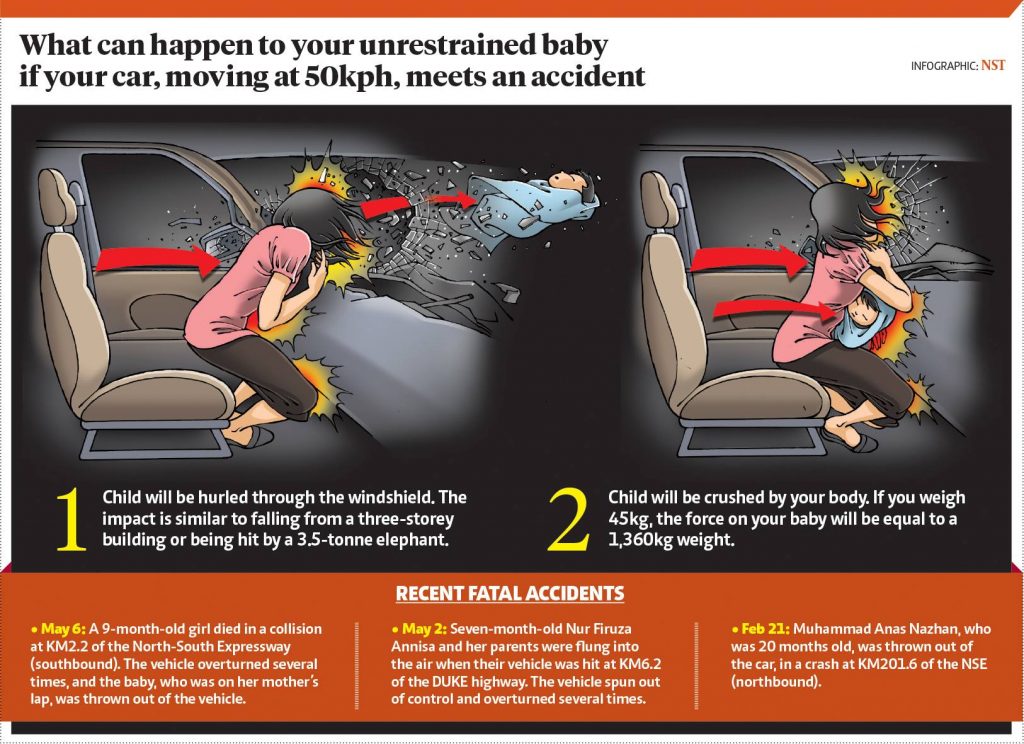If you’re a parent, you’ll agree that you put the safety and care of your children above just about everything else. All parents love their children and want to ensure that they keep them as safe as possible, especially while driving with them. In South Africa, it’s a legal requirement that all children under the age of 3 years must sit in a car seat. If your child is between the ages of 3 and 14 years or is under 1,5m in height, they should also be in a car seat. If one isn’t available, they should be strapped in using a seatbelt.
However, even using the best car seats, many parents are unaware that their toddlers could still be in great danger because of their incorrect use of the car seat. We’ve compiled some points that you can use to protect your child further. 1,2
Sadly, in South Africa, many children still suffer serious injury or death during car crashes because they were not securely fastened in their seats. While the car seat itself is not a magic formula for protecting your child, it is the first best step. The second step is correctly using the car seat. During a car crash, some children can fly out of their car seat or it’s often heard that the seat itself is found lying on the road. 2
We listed common car seat safety tips that can often be overlooked.
The car seat must fit well
Make sure that the car seat is appropriately suited to your child’s age, height, and weight. Some parents often move their children to the next size car seat too soon, which compromises their safety. Infants (around 12-18 months or 13kg or 75cm in length) should preferably be in rear-facing car seats as they are much safer than forward-facing ones. Weigh your child periodically to ensure his weight doesn’t exceed that displayed on the seat. 2
When are high-back boosters used?
High back boosters are ideal to protect older children, typically from the ages of four and onwards (18kg or 105cm in length). A booster is designed to make the safety belt go safely across a child’s body. Using a normal adult safety belt for children can result in the child suffering severe abdominal injuries and can even potentially cut the spinal cord. 2
Have you installed the car seat correctly?
Make sure to follow the car seat’s manual instructions exactly. Don’t alter or adjust anything as the protection that the seat offers may fail during a crash. Carefully follow the instructions where the seat belt secures the car seat to the car. Confirm whether your car seat needs a top tether anchor that secures the top part of the car seat using a strap with a hook. Install the car seat using the safety belt or Isofix but never both. 2
Are the straps at the correct height?
Follow the manual instructions to adjust the car seat straps on your child to the correct height. Harness straps on rear-facing seats must come from at, or just below, shoulder level. For forward-facing seats, the harness straps should come from at, or above, shoulder level. As always, make sure to check the car seat manual for specific instructions for your car seat. 2
Are the straps sufficiently tight?
It’s important to know that loose straps can slide off the child’s shoulders, which puts them in great danger during a crash. If the straps are loose, the child can be flung forward or out of their seat entirely. To test if the harness strap is tight enough, you should be unable to fit more than one finger between the collar bone and harness, commonly called the “One Finger Salute”. As always, check the car seat manual for step-by-step instructions on how to tighten the harness straps properly so as not to give too much slack in the wrong places. 2
What about twisted straps?
It’s important to straighten out twisted straps as they can increase the chances of injury due to misplaced forces. They can cut into a child’s body. Watch this video for a great trick to untwist the straps of the car seat. 2
Children sitting in the front seat
Airbags, while invented as a safety feature, can pose a very large threat to children sitting in the front seat. The trouble is that airbags activated during a crash are meant to protect adults and not children. Exploding airbags can prove fatal for children, so it’s vitally important that children stay in the backseat until they are 13 years of age. 2
Disclaimer
The above article is meant to give general information to help you understand the different characteristics of car insurance and safety in cars.
Protecting children in your car is one thing, but what about protecting your car with good car insurance? Why not contact PMD and discover more about their affordable car insurance products with world-class service and unique benefits like fixed premiums* and a reduce-to-zero excess*? T’s and C’s apply.
As with all financial services products, first consult a certified financial advisor to make sure the product is right for you.
Sources:
1 https://absolutemama.co.za/2018/11/16/car-seat-laws-regulations-and-best-practice/
This article was prepared by Eric Sandmann in his personal capacity. The views and opinions expressed in this article are the author’s own. The views and opinions in the article should not be attributed to anyone but the author unless expressly stated. Nothing in this article should be relied upon as advice, this publication is presented for informational purposes only. No person should act or refrain from acting in reliance on any information found in this article, without first obtaining proper financial advice from the appropriate professional. The author makes no claims, promises or guarantees about the accuracy, or completeness, of any information linked from, referred to, or contained in this article. The author reserves the right, to edit and change the content of this article.
